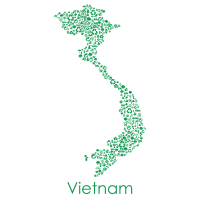2. Strategy for green development
In terms of environmental protection, green growth, energy strategy and the achievement of sustainability goals, the period between 2020 and 2022 has been particularly significant for the introduction of a significant number of reforms, among which the following stand out:
-
Politburo Resolution No. 55-NQ/TW : National Energy Development Strategy to 2030,
-
June 2020, Law of the National Assembly No. 64/2020/QH14, Law on Investments in the Form of Public Private Partnership ,
-
November 2020, National Assembly Law No. 72/2020/QH14, Environmental Protection Law
-
Prime Minister's Decision 1658/QD- TTg : National Green Growth Strategy 2030
-
April 2022, Decision No. 450/QD- TTg of the Prime Minister: National Strategy for Environmental Protection to 2030
-
June 2022, Prime Minister's Decision No. 687/QD- TTg : Circular Economy Development Scheme in Vietnam
The Vietnamese Government's intention to tackle head-on the issues of economic, environmental and social sustainability of the country's development model is evident, both by reorganising the regulatory platform and through administrative provisions that direct the actions of local administrations and agencies.
The specific objectives set out in the national strategy for green growth include
-
Contribute to the reduction of greenhouse gas emissions intensity by at least 15% in 2030 compared to 2014 and aim for net zero emissions in 2050.
-
Increase awareness and investment orientations of businesses and investors towards the circular economy model: promote the application of the circular economy model to promote the green transition of economic sectors.
-
By 2025, circular economy projects should enter the implementation stage and gather economic, social, technological and environmental effectiveness; contribute to the restoration of renewable resources, reduce energy consumption and increase the ratio of renewable energy to total energy supply, increase forest cover, waste recycling rates, import substitution rates of agricultural, forestry, fishery and export products.
-
By 2030, circular economy projects must become a primary driver for reducing energy consumption with greater or total autonomy in energy demand, using renewable energy and increasing forest cover.
-
-
By 2025, reuse, recycle and treat 85% of plastic waste generated; reduce plastic waste in the oceans and marine areas by 50% compared to the previous period; gradually reduce the production and use of non-biodegradable nylon bags and single-use plastic products. Dramatically increase the recycling capacity of organic waste in urban and rural areas. Raise awareness among agencies, organizations, businesses, communities and the general public about the production, consumption and disposal of plastic waste, non-biodegradable nylon bags and single-use plastic waste.
-
By 2030, 50% of municipal solid waste should be collected and treated according to standards and regulations through circular economy models; 100% of organic waste in urban areas and 70% of organic waste in rural areas are recycled; municipal solid waste landfill is no longer carried out in urban areas; maximize the percentage of urban wastewater collected and treated according to standards and regulations in urban areas.
